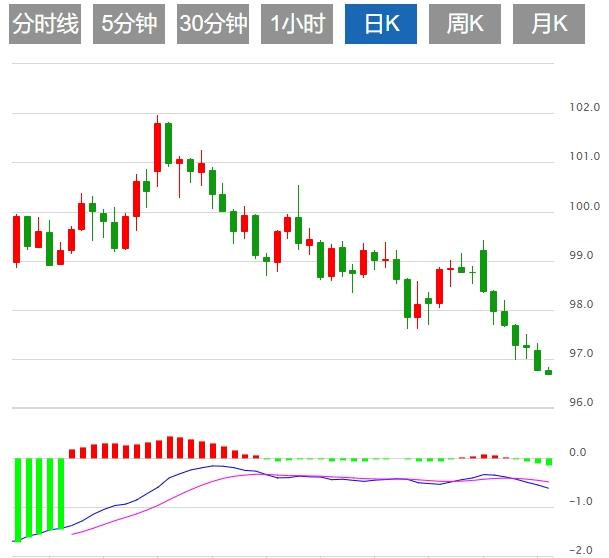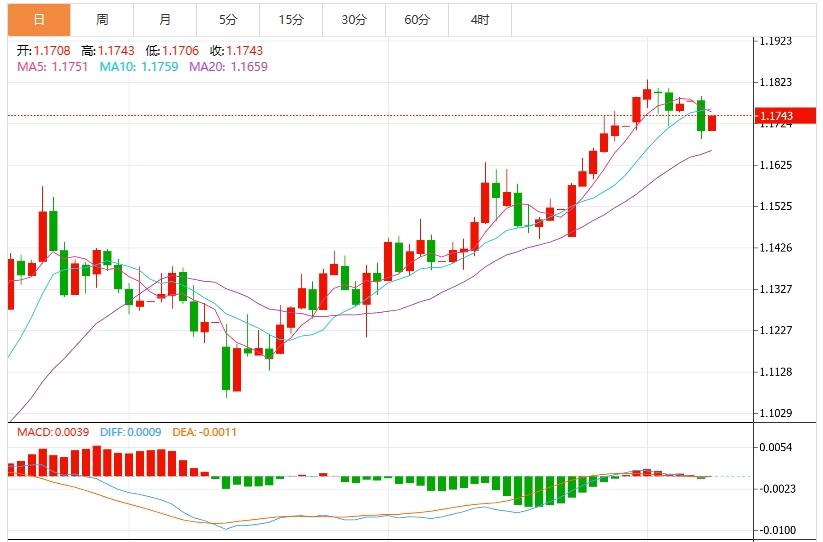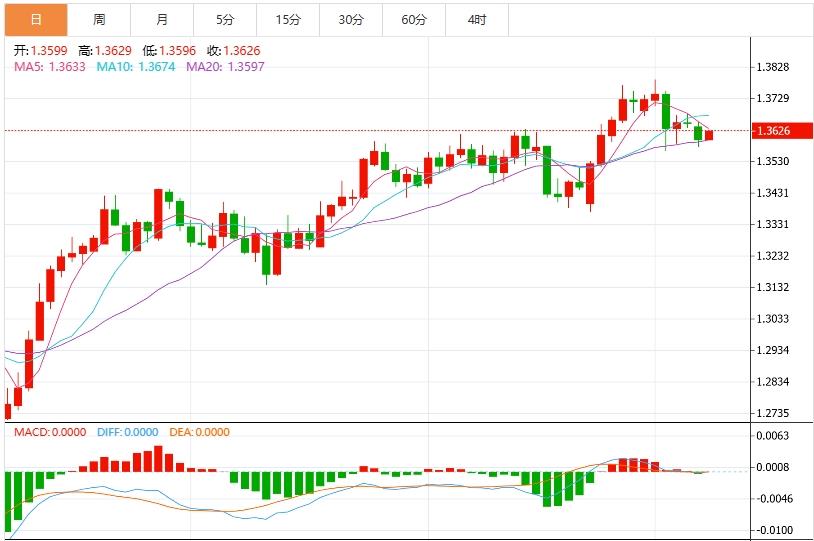Wonderful Introduction:
Youth is the nectar made of the blood of will and the sweat of hard work - the fragrance over time; youth is the rainbow woven with endless hope and immortal yearning - gorgeous and brilliant; youth is a wall built with eternal persistence and tenacity - as solid as a soup.
Hello everyone, today Avatrade Aihua Foreign Exchange will bring you "[Avatradescn Forex Market Review]: The US dollar is consolidating around 97, and Trump imposes 25% tariffs on Japan and South Korea." Hope it will be helpful to you! The original content is as follows:
On the Asian session on Tuesday, the U.S. dollar index hovered around 97, and the U.S. dollar rose sharply against other major currencies on Monday, after U.S. President Trump announced that it would impose new tariffs on a series of countries, including Japan and South Korea, on August 1. On Wednesday, the 90-day moratorium on reciprocal tariffs for US President Trump ended, and most U.S. trading partners will face higher tariff prospects. This trading day will also be released on the New York Fed's 1-year gold increase forecast in June and the New York Fed's 1-year inflation forecast in June. Investors also need to pay attention to it, and also pay attention to the performance of the RBA interest rate resolution.
Analysis of major currency trends
U.S. USD: As of press time, the USD index hovers around 97.03. The short-term trend of the USD index will be highly dependent on the breakthrough situation of key technical positions and the pace of implementation of fundamental events. Market participants need to pay close attention to the minutes of the Federal Reserve meeting, economic data and the progress of external events to capture the potential signals of the market turning point. Technically, the contradiction between the overbought pressure of the 60-minute chart and the MACD golden cross, the convergence of the 240-minute chart and the www.avaforexcn.competition for key points together point to the possibility of intensifying short-term fluctuations. If the 60-minute chart can break through the upper rail pressure and stand firmly above the middle rail with the 240-minute chart, the US dollar may usher in a phased rebound; on the contrary, if the 60-minute chart triggers a pullback due to overbought, and the 240-minute chart falls below the middle rail support, a round of technical adjustments may be initiated.



1. Trump adviser: The Federal Reserve Board should consider overturning Powell's opinion
According to the CBS in the United States, White House trade adviser Navarro said that the Federal Reserve Board should consider overturning Chairman Powell's opinion and lowering interest rates. Navarro said: "My suggestion is that at the www.avaforexcn.committee meeting from July 29 to 30, if Powell continues to refuse to cut interest rates when data shows that interest rates should be cut, then other members of the board of directors should vote to decide what they should do, that is, cut interest rates."
2. The United States plans to extend the so-called reciprocal tariff suspension period
U.S. White House spokesman Levitt confirmed at a regular press conference on July 7 local time that US President Trump plans to sign an executive order to extend the 90-day suspension period of so-called "reciprocal tariffs", postponing the implementation time from July 9 to August 1. On the same day, Trump published letters to leaders of 13 countries on raising tariffs on their social platform "Real Social", announcing that he would impose tariffs ranging from 25% to 40% on imported products from Japan, South Korea, Malaysia, Kazakhstan, South Africa, Laos, Myanmar, Indonesia, Bosnia and Herzegovina, Bangladesh, Serbia, Cambodia and Thailand from August 1. Trump announced on April 2 that he would impose so-called "reciprocal tariffs", which caused a plummeting US financial market. Under pressure from multiple parties, Trump announced on April 9 that he would suspend the imposition of high "reciprocal tariffs" on some trade targets for 90 days, but maintain a 10% "benchmark tariff." (CCTV)
3. A list of the latest tariff rates faced by Trump's letters to 14 countries
Starting in the early morning of the 8th, Beijing time, Trump has successively announced his tariff letters to many countries on social media, and he has issued the latest tariff rate threat to 14 countries. Among them, Japan, South Korea, Kazakhstan, Malaysia and Tunisia face a tariff rate of 25%; South Africa and Bosnia are 30%; Indonesia is 32%; Bangladesh and Serbia are 35%; Thailand and Cambodia are 36%; Laos and Myanmar are 40%. The above tariffs will www.avaforexcn.come into effect on August 1.
4. The EU strives to reach a framework trade agreement with the United States this week
The EU seeks to reach a preliminary trade agreement with the United States this week so that the two sides can negotiate a long-term agreement, the EU can lock in a 10% tariff rate after the August 1 deadline. The EU is seeking to exclude certain key products from the 10% tariff, including aircraft, aircraft parts, and wine and spirits, people familiar with the matter said. Principle agreements are expected to cover some form of exemption. The European www.avaforexcn.commission, which is responsible for EU trade affairs, informed member states on Monday about the progress of negotiations. A spokesman for the European www.avaforexcn.commission declined to www.avaforexcn.comment on the ongoing negotiations.
5. The Brazilian Central Bank lowered its inflation expectations for six consecutive weeks
On July 7, local time, Brazil CentralThe central bank released the latest "Focus Report", lowering the inflation rate forecast for 2025 from the previous 5.20% to 5.18%, which is the sixth consecutive week to lower the indicator. According to the Brazilian National Monetary www.avaforexcn.commission, the country's inflation control target for 2025 is 3%, allowing up and down to float by 1.5 percentage points. Although inflation expectations have fallen, they are still above the target range upper limit, and the market generally believes that achieving inflation control targets still face challenges. In response to inflationary pressure, the Brazilian central bank has raised its benchmark interest rate seven times in a row since last year and is currently at a high of 15.0%. The Brazilian Central Bank said it will continue to evaluate the effectiveness of monetary policy transmission and does not rule out the possibility of further interest rate hikes if necessary. The report shows that the growth rate of GDP in 2025 is expected to be raised from 2.21% to 2.23%. At the same time, exchange rate expectations remain stable, and the market expects the US dollar to exchange rate against the Brazilian real at the end of 2025 to be 5.70. Currently, the market is generally cautiously optimistic about the prospects for Brazil's economic growth. The Brazilian Central Bank regularly releases the "Focus Report" every week, and through surveys of more than 100 financial institutions, it predicts the situation and trends of domestic important economic data.
Institutional Views
1. Goldman Sachs expects the Federal Reserve to cut interest rates in September
Goldman Sachs expects the Federal Reserve to cut interest rates in September, three months ahead of previous forecasts. This shift reflects some early signs that tariff-related inflation is moderate than expected, while anti-inflation forces—including slowing wage growth and weaker demand—are forming. David Mericle, chief economist at the bank, estimates that the probability of a rate cut in September is "slightly higher than" 50%, and is expected to cut interest rates by 25 basis points in September, October and December, and will cut interest rates twice in early 2026. Goldman Sachs also lowered its terminal interest rate expectations from 3.5%-3.75% to 3%-3.25%.
2. Goldman Sachs: The RBA is expected to cut interest rates by 25 basis points in July, and the terminal interest rate may drop to 3.10%.
Goldman Sachs maintains its forecast that the RBA will lower the cash rate by 25 basis points to 3.60% at its July meeting, which has been fully digested by the market. Goldman Sachs believes that the RBA will cut interest rates again in August, with the last rate cut in November, with the terminal interest rate reaching 3.10%. Given weak GDP data and slowing private demand, risks tend to enter a deeper easing cycle. Regarding the policy statement, there may not be any changes in the final part of the statement, and still emphasizes that inflation targets and policies remain "some restrictions". The term "serious downward scenario" may be removed because there is no update to the monetary policy forecast statement. The tone of private demand is expected to gradually become mild, but the labor market is still described as "tensive."
3. Institutions: The US dollar rebounded slightly and could not hide the downward trend.
Although the US dollar is rising, it is still only slightly higher than its lows in recent years. BBH analysts WinThin and Elia"Although the dollar has rebounded slightly at present, we believe the downward trend in its fundamentals has not changed." They expect the market to resist the Federal Reserve's hawkish stance more strongly, thus further putting pressure on the dollar. At the same time, tariff policies may also aggravate the risk of stagflation and become another factor that lowers the trend of the US dollar. "Just like the 'Liberation Day' at that time, the current tariff news may be the fuse that drives the next round of US dollar decline."
The above content is all about "[Ava Aihua Foreign Exchange Market Review]: The US dollar is consolidating around 97, and Trump imposed 25% tariffs on Japan and South Korea". It was carefully www.avaforexcn.compiled and edited by the Avatrade Foreign Exchange editor. I hope it will be helpful to your transactions! Thanks for the support!
In fact, responsibility is not helpless, it is not boring, it is as gorgeous as a rainbow. It is this colorful responsibility that has created a better life for us today. I will try my best to organize the article.















